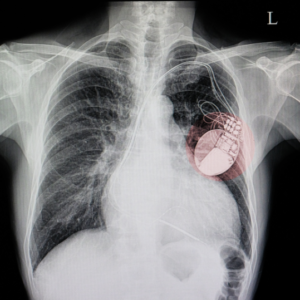Pacemaker Implantation
Abnormal Heart Rate?
Pacemakers help regulate a heart condition wherein the rate can fluctuate between fast or slow.

Pacemaker Implantation in Bangalore
Overview
A pacemaker is used to treat patients with arrhythmia (or abnormal heartbeat). It is a small electronic device that is usually placed in the chest (just below the collarbone) to help regulate electrical discrepancies with the heart. A pacemaker may be recommended to ensure that the heartbeat does not behave abnormally or slow to a dangerously low rate.
What are the Different Types of Pacemakers?
- Single chamber pacemaker
- Dual chamber pacemaker
- Implantable cardioverter Defibrillator (ICD)
- Cardiac resynchronisation therapy (CRT) for heart failure patients.

What Indicates That A Pacemaker Is Required?
The heart can be seen as a pump made up of muscle tissue that is run by electrical currents, which normally follow a specific electrical circuit within the heart. A Pacemaker may be needed when problems occur with the electrical conduction system of the heart.
There are few symptoms that can be observed in patients. These suggest that your heart’s health requires immediate medical attention, they are:
- A slower pulse than normal
- Extreme tiredness (fatigue)
- Fainting or syncope
- Dizziness or lightheadedness
- Shortness of breath
- Chest pain
- Irregular or fluttering heartbeats (palpitations)
Pacemaker FAQs
Each time the heart beats, the heart muscle contracts (pulls inwards) in preparation for pumping blood around the body. These contractions are triggered by electrical pulses. A pacemaker is needed when problems occur with the heart’s electrical conduction system. When the timing of the electrical stimulation of the heart muscle and the subsequent response of the heart’s pumping chambers is changed or altered, a pacemaker may help. Pacemaker is needed in those who has very slow heart rate i.e. Complete heart block, heart failure and those having recurrent ventricular tachycardia to prevent sudden cardiac death.
The pacemaker is implanted by making a small incision below the collarbone. Then a tube is inserted into a blood vessel. This tube is then advanced to the heart and will become a pathway for the electronic device. Then your cardiologist will introduce a Lead Wire through the blood vessel. This Lead Wire is then connected to Generator that too will be slipped into the skin under the collarbone.
Any appliance that produces a strong electromagnetic field, like an induction stove, can interfere with a pacemaker. Most common household electrical equipment, such as hairdryers and microwave ovens, will not be a problem, as long as you maintain a safe distance from them. Mobile phones do not affect pacemaker function. Things that might affect the functioning of your pacemaker can be:
- Shopping security systems
- Metal Detectors
- Magnetic bracelets/watches
- MRI scans
- Transformers
Most people who have a pacemaker implanted feel it has positively impacted their life. Having a pacemaker can help you be more active. It may also help you stay out of the hospital and extend your lifespan. Previous symptoms, such as syncope, fainting, breathlessness or dizziness, will subside.
In most cases, it is usually considered a minor surgery that should only take around one to two hours to perform. During this surgery, you’ll most likely be conscious, and the surgery will be performed with local anaesthesia to numb the incision site.
Pacemakers are used to treat certain types of arrhythmias, as well as heart failure, a condition that occurs when the heart cannot pump sufficient blood to the body. Pacemakers may also be used to help your heart chambers beat in synchronisation if your heart isn’t pumping sufficient blood to your body.
Usually, be able to do all the things after around 2 days except you will need to restrict the movement of the arm where pacemaker is implanted. Your cardiologist will usually be able to advise you about this. It’s best to avoid strenuous tasks on the side you had your operation on for 4 to 6 weeks. And as a general precaution stay away from electromagnetic emitting appliances.
-Single chamber pacemaker
-Dual chamber pacemaker
-Implantable cardioverter Defibrillator (ICD)
-Cardiac resynchronisation therapy (CRT) for heart failure patients.
